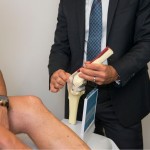
Although keeping active is important for bone and muscle strength, participating in sports such as rugby league, soccer, netball, golf, tennis and skiing can lead to some of the most painful injuries. The majority of sports injuries are a result of trauma to ligaments, muscles, and tendons. Athletes can usually determine if they have an injury by the immediate pain or swelling, and discolouration to the impacted area.
Sprains
A sprain usually occurs as a result from stretching or tearing a ligament, most frequently located in the ankles, knees and wrists. The degree of damage will depend on whether the tear is partial or complete, and the number of ligaments involved. It is generally caused by force.
Strains
A strain is an injury where either a muscle or a tendon is torn causing pain and loss of function. A strain is usually caused by overuse, force, or stretching. It is common for a strain to impact the lower back or the hamstring muscles (located behind the knee and thigh).
Tears
Tears to a ligament usually occurs when a joint is forced beyond its normal range of motion, such as a sudden bend, twist, or change of direction. Tearing a ligament is most common in knees and ankles, and is usually noticeable by inflammation and spasms in the affected area.
It is imperative to treat your sporting injuries through surgical or non-surgical treatments to help reduce the possibility of further damage in the future. If non-surgical treatments such as RICE (rest, ice, elevation, and compression) don’t work, you will need to seek specialist help, especially if you are in doubt or experiencing the below:
- You have severe pain and cannot put any weight on the injured area
- There is swelling, or redness over the injured area
- The injured area or next to it is very tender to touch
- The injured area looks disfigured (crooked, lumpy, bumpy etc.)
- You cannot move or walk with the injured joint without experiencing pain
- Your limb buckles or gives way when you try to use the joint
- Numbness in any part of the injured area
Preventative solutions
To avoid strains, sprains and tears there are a number of habits to adopt into your routine which can help reduce the risk. These include:
- Maintain a healthy, well-balanced diet to keep muscles strong
- Maintain a healthy weight to reduce pressure on bones and joints
- Wear shoes that are in good condition and fit properly
- Do stretching exercises daily, and warming up before participating in any sports or exercise
- Wear protective equipment when playing
- Run on even surfaces
After non-surgical attempts are made to treat sporting injuries (or if these are not deemed an adequate treatment option), surgery will be considered to repair any damaged ligaments, muscles or tendons. As sporting injuries are unique to each patient and condition, the best course of treatment is determined with a thorough physical evaluation. Dr Shidiak will also discuss post surgical rehabilitation programmes before any surgery to achieve the best outcomes.
To find out how Dr Shidiak can help, please click here. Alternatively you can contact us on 02 9806 3333 for more information or to book in a consultation.


